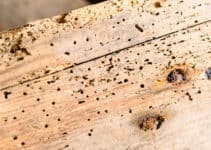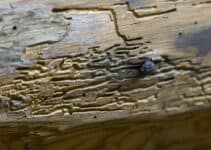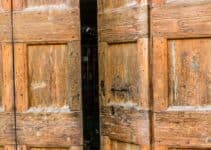In period homes or homes with older furnishings, woodworm or their threat is always going to create some anxiety.
It is always a good strategy to be informed and prepared to act at the first signs of woodworm being present in the structural timber of your home or its furnishings.
But can woodworm eat through paint? Luckily woodworm cannot penetrate wood that is either painted or varnished because the liquid is toxic to them.
Let’s look at this in more detail.
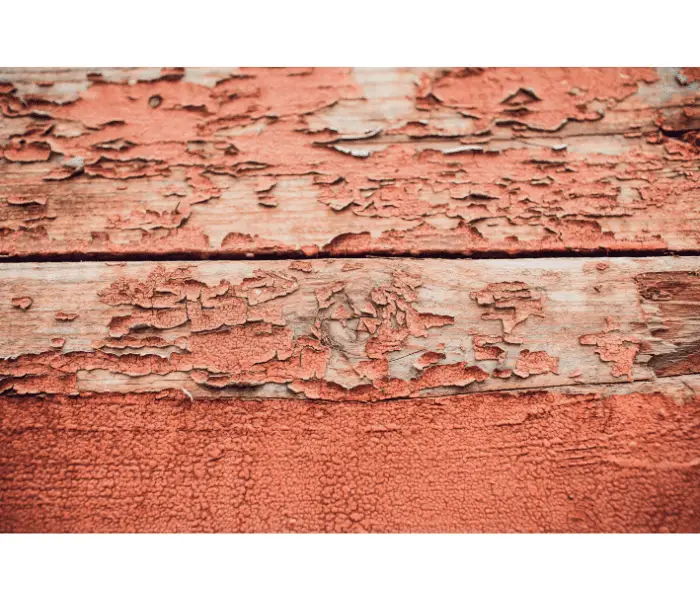
Can Woodworm Go Through Paint?
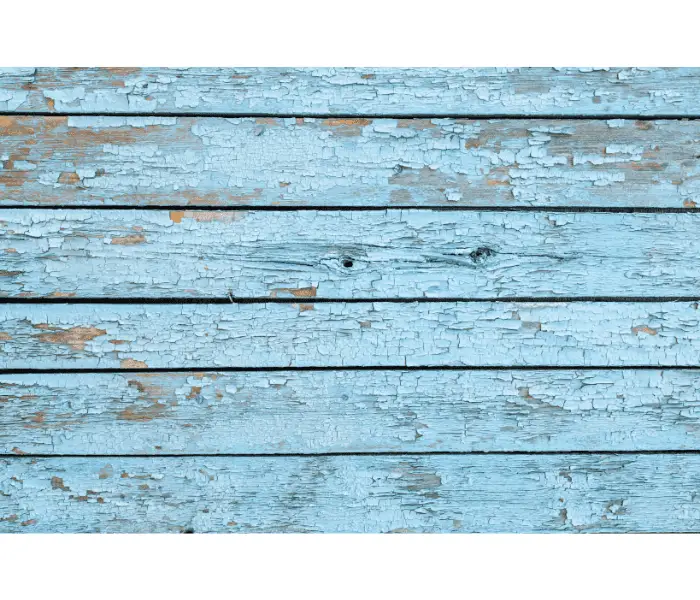
The good news is that woodworm can’t bite through painted or varnished wood as it is toxic to them. The less good news is that the tell-tale signs of woodworm being present in timber – those familiar holes in wood – will not occur until woodworm are ready to leave the wood which can take between 2 to 5 years.
This means paint could be applied to the surface of the wood after the beetles have infested it and undermined its integrity from within. That really means any wood is at risk of having woodworm unless it is pre-treated.
I like using this as a pre treatment to apply to my beams, its easy to apply without much odour:
Painting Over Woodworm
Why is Paint Not Always Enough Protection Against Woodworm? The misconception at the heart of most conversations about woodworm is based on the assumption that the holes which indicate their presence are the entry points for the beetles – this is incorrect.
In fact, female beetles lay their eggs in minute cracks in timber and the larvae form downwards, below the surface of the wood a few weeks after.
The larvae then have access to all the wood below the surface to eat until they reach maturity. The larval stage can last between two to five years and so the damage that can be done during that period can be extensive.
Unfortunately, it’s unlikely you will detect an infestation at any point during this part of the woodworm’s life cycle.
Paint or varnish might be applied to the timber during this time and it would not stop the timber from the infestation that has already occurred or from structural damage going on beneath the surface.
Towards the end of its life cycle the larvae tunnels to the surface and forms a chamber in which to pupate into a beetle. It then eats through the outside of the timber to create the familiar exit holes.
Of course, painted wood or varnish may kill the adult beetle at this point but it will not have stopped the internal damage that it has already done.
Can You Treat Woodworm – Infected Wood with Paint?
If you know the wood you are painting is free of woodworm then paint or varnish is a good barrier. Common furniture beetles cannot penetrate through paint to lay eggs so you can prevent an infestation of woodworm in this way.
Make sure that paint or varnish is applied comprehensively, coating all the timber. Furniture beetles only need the tiniest crack in paint and in the wood to lay their eggs so do not skimp on the preparation or the attention to detail when painting especially at joints.
Having said that, paint or varnish will not ‘treat’ already infected timber. While paint may kill some of the woodworm by penetrating through previous exit holes which allow greater penetration into the wood, it will not affect all the worms that are eating their way to adulthood beneath the surface.
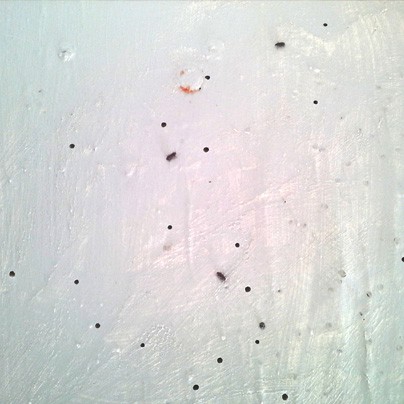
Applying woodworm treatment before painting is essential if you know your timber is suffering from woodworm. If the woodworm-infected timber is already painted, you will need to strip it off completely before applying the woodworm killer.
And if you wish to paint older furniture which has signs of previous woodworm infestations, the best advice is to treat it with woodworm killer and then a wood preservative. This covers as many potential problems as possible before applying the paint or varnish.
Can You Paint Over Woodworm Holes?
Woodworm holes can be painted over, but proper treatment is essential beforehand. Infestations should be treated with a woodworm solution, ensuring the larvae are killed.
Painting Over Borer Holes
Once treated, the borer holes can be filled with wood filler or putty, then sanded smooth. A suitable primer must be applied to the surface, followed by the desired paint, achieving a flawless finish.
I love this primer, its clear and drys quickly:
Can You Paint Over Woodworm Treatment?
Absolutely! You can paint on woodworm treatment, but it’s worth sanding your timber before applying any treatment to allow deeper penetration into the wood.
Once you have applied woodworm treatment or killer (check the details of your product) you should allow it to dry thoroughly and then you can paint directly over the treatment without any further preparation.
Remember that woodworm thrive in damp or humid environments and paint will deteriorate in these conditions making it vulnerable to future attacks. Always check the surface of your painted timber for areas that are less well covered and apply more layers if necessary.
Timber joints are especially vulnerable as beetles find it easier to lay eggs in existing cracks.
Always make sure your paint is suitable for the environment of your timber. Exterior or interior paints must be used according to the manufacturers’ guidance.
And, as with all things, keep your eye open for the tell-tale signs of woodworm in your timber even if it is painted or varnished: bore dust (frass), exit holes, tunnelling and the beetles themselves. At the first sign, you will know how to take action!
How to Treat Woodworm in Painted Wood
If you haven’t yet treated the wood it isn’t too late. To treat woodworm in painted wood, follow these steps:
- Safety First: Wear protective clothing, gloves, goggles, and a dust mask to protect yourself from wood dust, chemicals, and potential irritants.
I don’t start any job without my goggles:
2. Remove Paint: Before treating the wood, remove the paint to ensure the treatment penetrates effectively. Use a paint stripper or a heat gun, following the manufacturer’s instructions and safety guidelines. Sand the surface with medium-grit sandpaper to expose the bare wood.
This paint stripper is great for wood:
3. Choose Treatment: Purchase a suitable woodworm treatment solution, preferably one with a low VOC (volatile organic compound) content and a long-lasting effect. Look for products that contain permethrin, cypermethrin, or boron as active ingredients. Follow the manufacturer’s instructions regarding application and safety precautions.
This is my favourite, I’ve been using it for years to keep woodworm away from my cottage:
4. Apply Treatment: Apply the woodworm treatment to the exposed wood surface, ensuring all holes and surrounding areas are thoroughly covered. Use a brush or a low-pressure sprayer to apply the treatment, and work systematically across the entire surface.
If you’re lazy like me you can use the spray version!
Pay attention to joints, corners, and any hard-to-reach areas.
5. Repeat Application: Depending on the severity of the infestation, you may need to apply multiple coats of the treatment. Follow the manufacturer’s guidelines for the recommended number of applications and drying time between coats.
6. Allow to Dry: Let the treated wood dry thoroughly, as per the manufacturer’s recommendations. This may take a few days to a week, depending on the product and environmental conditions.
7. Seal and Repaint: Once the treatment is dry, seal the wood with a suitable primer or wood sealer to prevent moisture from re-entering. After the primer or sealer has dried, repaint the wood with a high-quality, water-resistant paint.
8. Monitor and Maintain: Regularly inspect the treated area to ensure the woodworm infestation is under control. Perform periodic maintenance by cleaning, sealing, and repainting the wood as needed to protect it from future infestations.
9. Dispose of Materials: Properly dispose of all used materials, such as brushes, rags, and paint stripper residue, following local regulations for hazardous waste disposal.
Woodworm Paint
In summary, treating woodworm in painted wood involves removing the paint, applying a suitable treatment, allowing it to dry, and then sealing and repainting the wood.
It is essential to follow safety precautions and manufacturer’s instructions throughout the process, monitor the treated area for any signs of reinfestation, and maintain the wood to prevent future infestations.






